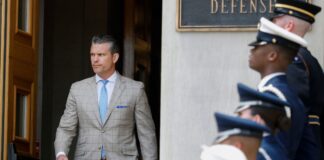In the past few weeks, Americans learned that Robert F. Kennedy Jr. canceled half a billion dollars of government investment in the development of mRNA vaccines, Las Vegas saw a 7 percent drop in visitors, residential electricity prices shot up by an average of 6.5 percent, the number of housing permits issued hit their lowest point in half a decade, employers quit adding workers, the manufacturing sector shrank, and inflation rose.
These bleak figures depict an American economy slowing and its labor market weakening. A recession isn’t guaranteed, but it’s becoming much more likely and the stagflation that forecasters described as inevitable when President Donald Trump began prosecuting his global trade war is now a lot closer. Americans, now and in the future, will be paying more and buying less. Trump’s second-term economic ideology is not only one of protectionism, mercantilism, atavism, and cronyism. It is also one of degrowth.
Trump, who entered the White House promising to slash prices on household goods and supercharge the American economy, would never use that term himself. Degrowth—the notion that wealthy countries can and should reduce their consumption and production—is associated with environmental activists and leftist and green parties in Europe. Still, at its heart, degrowth argues that people should not only tolerate but desire a smaller economy. That’s second-term Trumponomics, and everyone stands to be worse off for it.
Without admitting it, the White House is pursuing a multipronged strategy to raise prices, suppress consumption, freeze production, and lower productivity in the United States. The trade war is the most obvious example, as well as the one having the most immediate consequences. Since January, Trump has raised and lowered and raised tariffs on goods imported from American allies around the world. Such barriers will eliminate the country’s bilateral trade deficits and boost domestic manufacturing, the White House has promised, while warning that consumers and employers might have to endure a chaotic period of adjustment.
But Trump has slapped tariffs on commodities and parts that factories use to make things in America, such as engine components and timber. He has slapped tariffs on products that are not or cannot be produced here, such as bananas and gallium. And he has slapped tariffs on items that would be too expensive for American consumers to purchase if they were made in this country, given the cost of American wages and the network of factories in operation, such as costume jewelry and sneakers. The Yale Budget Lab estimates that the country’s effective tariff rate now stands at 18.3 percent, the highest since 1934. Prices are beginning to rise as importers pass the cost of Trump’s import taxes on to retailers and families. Industrial production is falling, as uncertainty plagues the sector.
In response, Trump has argued with reality. “We’re only in a TRANSITION STAGE, just getting started!!! Consumers have been waiting for years to see pricing come down,” he wrote on Truth Social. “NO INFLATION,” he added, pointing to egg and gas prices. But those are just two of 80,000 prices the government tracks each month to calculate the overall inflation rate. The cost of eggs has declined as the bird-flu pandemic has waned; the price at the pump has gone down due to weaker global growth and increased OPEC production. Across the economy, costs have remained witheringly high, despite the Federal Reserve combatting them with high interest rates. If the Fed cut borrowing costs, inflation would climb.
Trump’s campaign against reality extends beyond the price of consumer goods. Unhappy with the pace of employment growth, the president canned the head of the Bureau of Labor Statistics. “Important numbers like this must be fair and accurate,” he wrote on Truth Social. “They can’t be manipulated for political purposes.” (Touché.) Unhappy with Fed policy, he has threatened to put Jerome Powell, his own appointee, “out to pasture.”
At the same time as he has prosecuted his bizarre unilateral war on imports, Trump has reduced government subsidies for a range of necessities. He has taken $1 trillion away from Medicaid, while vowing not to reduce the program’s budget. He has cut food-stamp benefits, meaning low-income families will buy fewer groceries. He has eliminated support for the loans and grants that poor kids rely on to get a higher education. And he has slashed financing for renewable-energy production.
Each of these policies will raise costs and reduce supply. Trump’s One Big Beautiful Bill Act, for instance, is expected to eliminate 1.6 million green-energy jobs and reduce electricity-generation capacity by 330 gigawatts by 2035. (That’s roughly equivalent to the country’s current solar-production capacity.) Americans a decade from now will pay higher prices for electricity and will use less of it, thanks to Trump.
Right now, the United States is suffering from shortages—yes, shortages—of immigrants and visitors. Tourist meccas around the country are reeling as visitors from Europe and Asia opt to take their euros and yen elsewhere. Farms and nursing facilities are suffering from a lack of workers. Global investors are opting to park their money abroad, raising domestic borrowing costs and weakening the dollar.
In the long term, Trump’s attack on colleges and scientific-research institutions might end up being the most damaging of his degrowth policies. The American system of higher education—for all of its many, many faults—is an engine of global modernity. The country’s land-grant schools help feed the world. Its public colleges vault poor kids up the income ladder. Its name-brand universities are laboratories of scientific innovation.
But for the crime of supporting Black and brown kids, admitting foreign students, and hiring liberal thinkers, these institutions are under assault. The mathematician Terence Tao, described by some of his contemporaries as a latter-day Albert Einstein, might not be able to continue his research at UCLA, because of Trump’s budget cuts. What good could possibly come of that? The same good that will come from slashing financing for mRNA-vaccine research, meant to prevent cancer and end pandemics. “I’ve tried to be objective & non-alarmist in response to current HHS actions—but quite frankly this move is going to cost lives,” argued Jerome Adams, a physician who served as surgeon general during the first Trump administration.
As a counterweight, the White House has cut taxes and slashed regulations, for some industries at least. The wealthy stand to do just fine in the Trump economy—happy, I suppose, to have a smaller pie if they get a bigger piece of it. Yet Trumpian degrowth will hurt them, too, in time. Rich people purchase homes and sneakers and bananas, and send their kids to college. Rich people use energy. Rich people hire workers to provide them with home-health support and staff their businesses. And rich people use vaccines and require cancer treatments.
Unlike typical degrowthers—with their focus on long-term human flourishing and the conservation of the planetary ecosystem—Trump is engaged in financial nihilism. The president has, at least once, admitted that his policies will lead to Americans having less instead of more: “Maybe the children will have two dolls instead of 30 dolls, you know? And maybe the two dolls will cost a couple of bucks more than they would normally.” If only that was the worst of it.




